When designing various flower beds in the front yard, it is important to approach the process thoughtfully. It is advisable to create a layout of the area and choose the most advantageous options for the configuration of future plantings, with a distribution of color spots. This will help avoid mistakes when purchasing decorative plant seeds.
Designing flower beds – the main principles of creating a garden
When developing a picturesque flower bed, it is important to follow a set of rules for its rational design and to understand the terminology. Generally, there are two groups:
- Flower beds that have a regular shape with strict geometric parameters.
- Varieties of flower beds with any, sometimes unexpected, configuration.
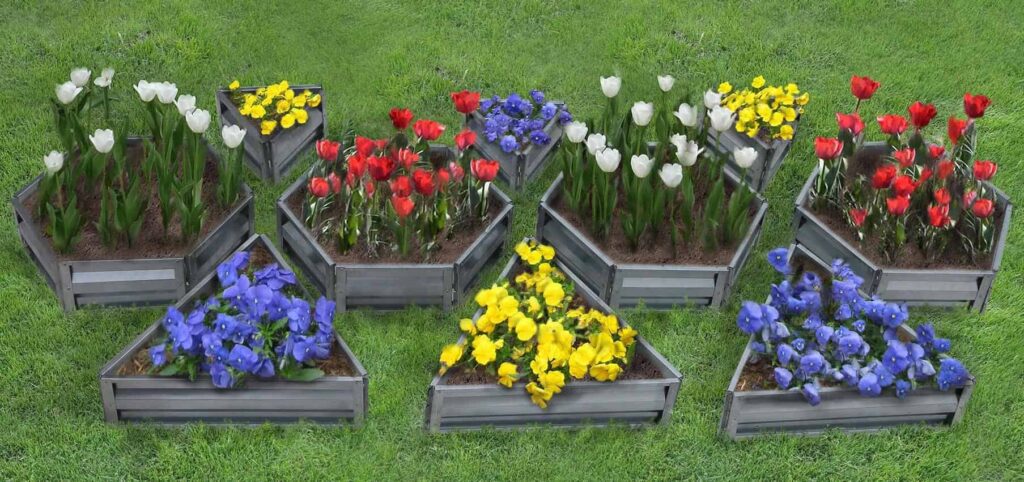
Designing a flower bed involves specific principles, such as
- Unity: To create a harmonious overall look, it’s essential to consider the form, color combinations, and whether or not to add borders.
- Multilevel: Since flowers play a dominant role in decorating the space, it’s important to ensure each plant is visible. Shorter plants can be placed at the front or along the perimeter.
- A well-thought-out plan: There are many ways to create flower beds, and it’s crucial to integrate the chosen design with the surrounding landscape.
Flower beds and gardens are common features in country homes.

When planning the design of a summer cottage plot by placing flower beds on it, it is necessary to analyze the information about the dominant types of such landscape elements.
Flower border
A flower border is a visually pleasing narrow strip of attractive plants. It lines pathways or delineates functional zones. It’s often used to outline a rock garden or large flower beds.
Typically, you use low-growing compact plants for such plantings as they’re perfect for this purpose. Moreover, they adapt better to the soil and don’t require special care.
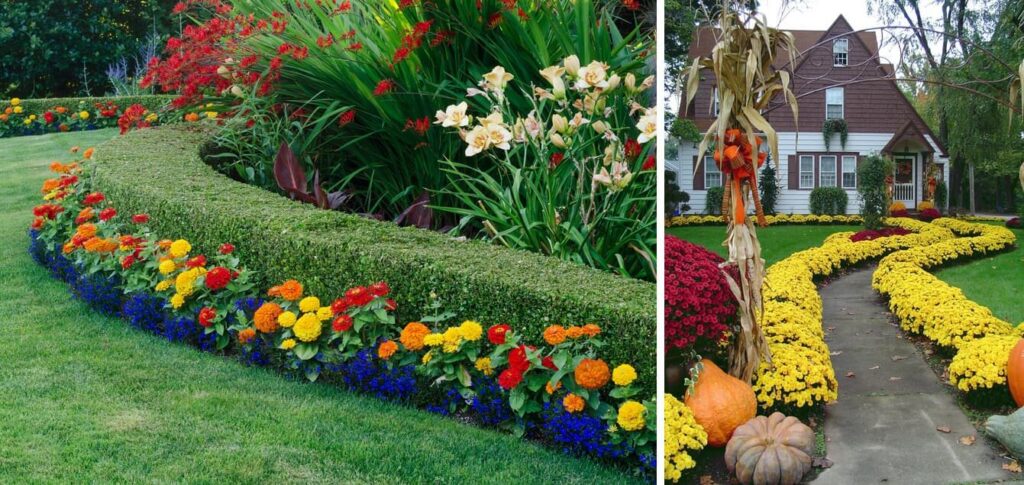
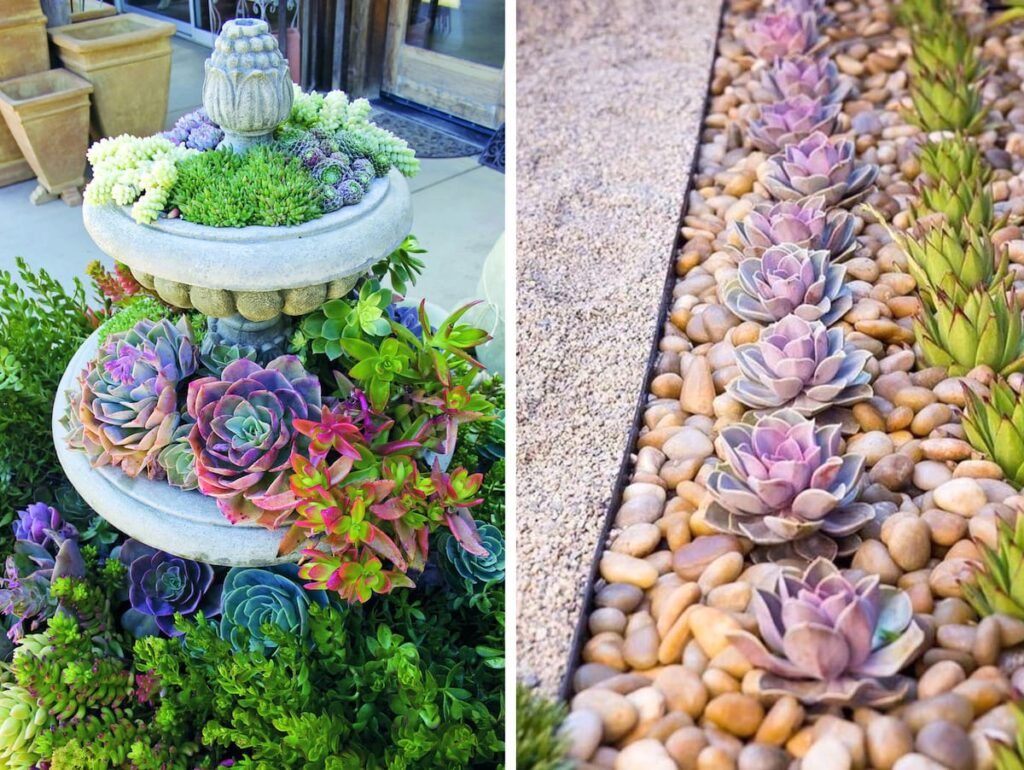
Flowerbed
A flowerbed is a traditional type of garden bed that is rectangular in shape. You can choose plants for their varying shades, or you might prefer a single-colored background. The planted varieties may have different variations in shape and height.

Mixed border
You can use a mixed border to decorate the space along the walls of buildings. With the right floral ornament, you can give even the most inconspicuous structure a charming look. Here, you can plant different varieties of flowers and plants that don’t require any special care.
The dominant option for mixed border flower beds is the selection of decorative plants that provide continuous flowering. Making such flower beds in your own garden is very easy, as it does not require any special skills.
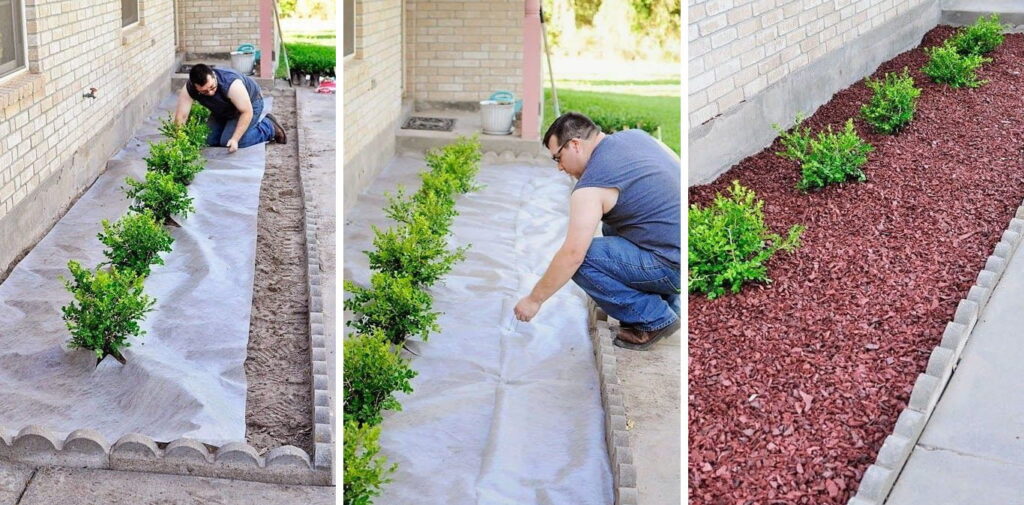
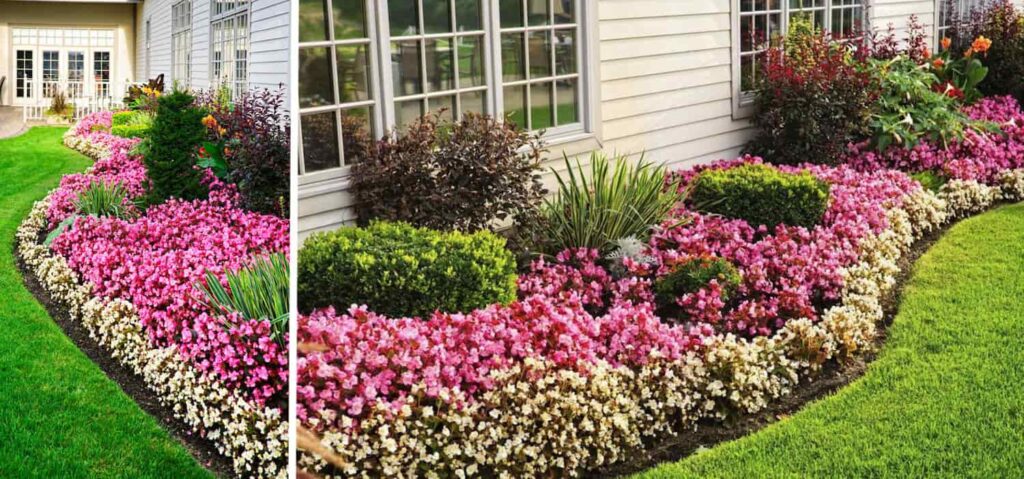
Vertical flower bed
A vertical flower bed allows you to beautifully and efficiently decorate small areas. A vertical flower bed in a garden attracts with its original design and a variety of compositional solutions.
Interesting shapes can be achieved with the help of wire mesh frames covered with film and filled with soil mix. Such flower beds look great near verandas and terraces attached to the house.
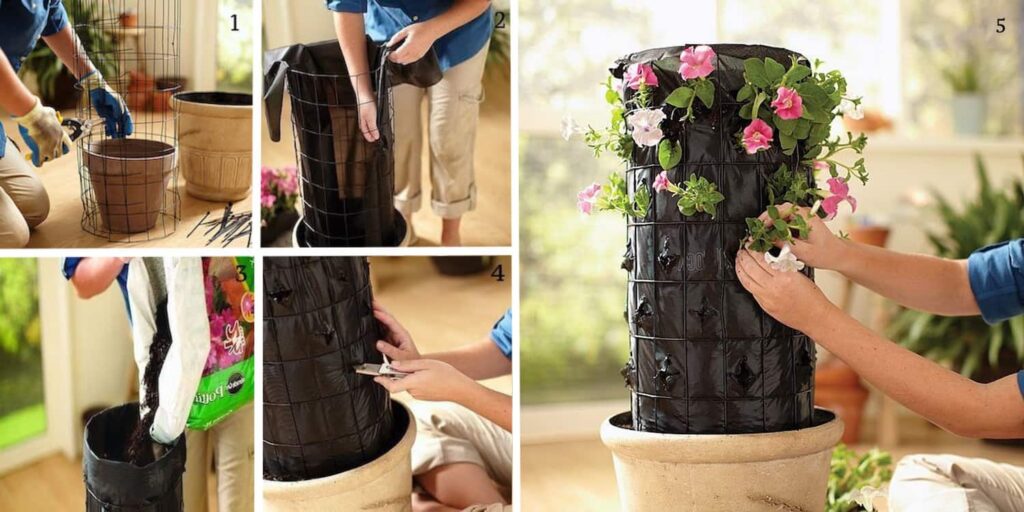
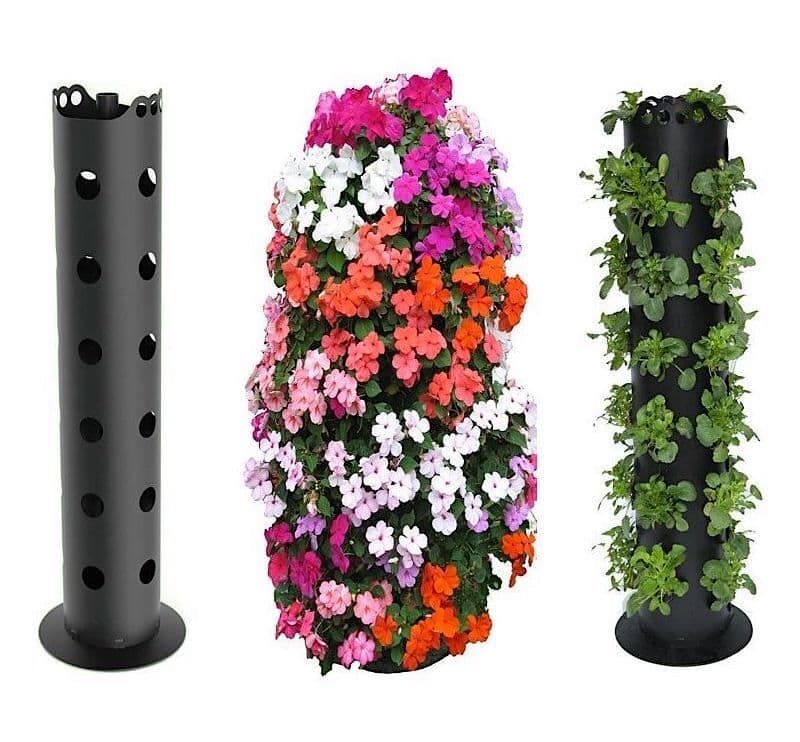
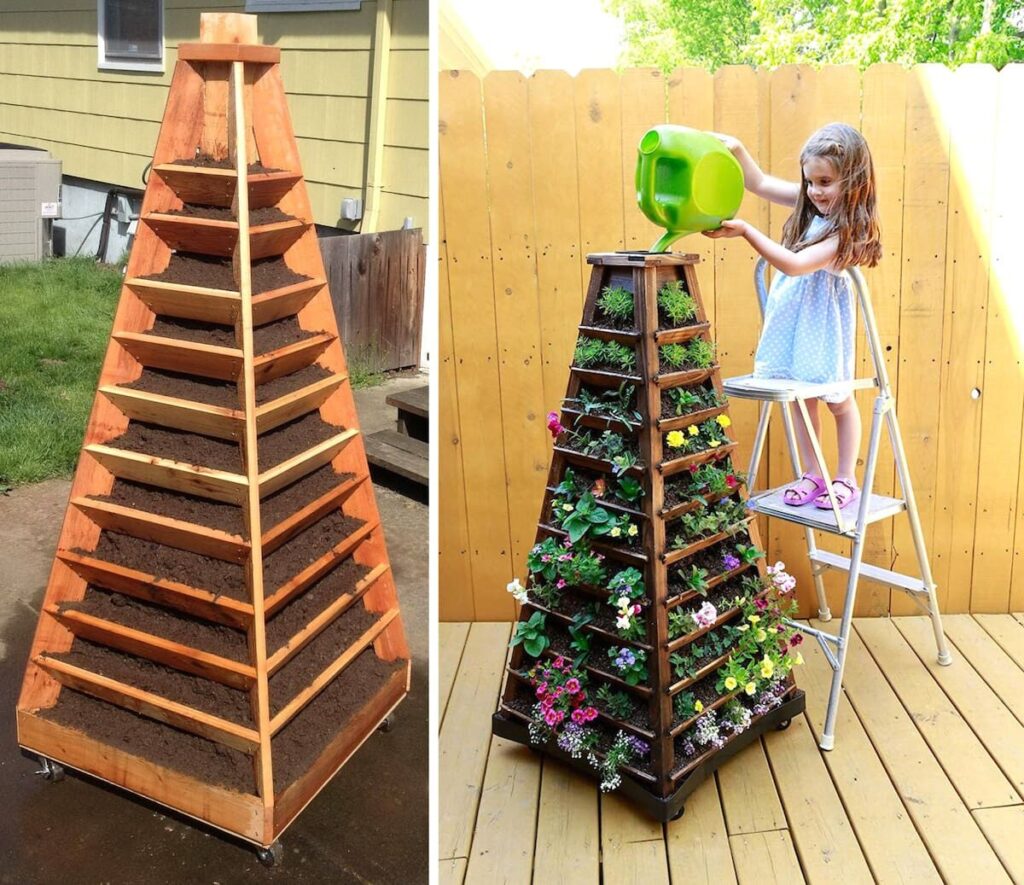
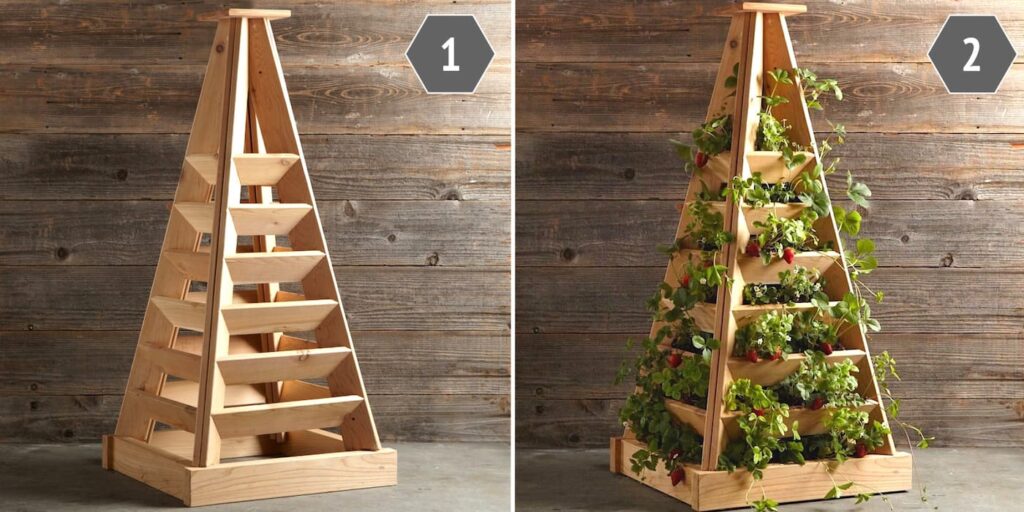
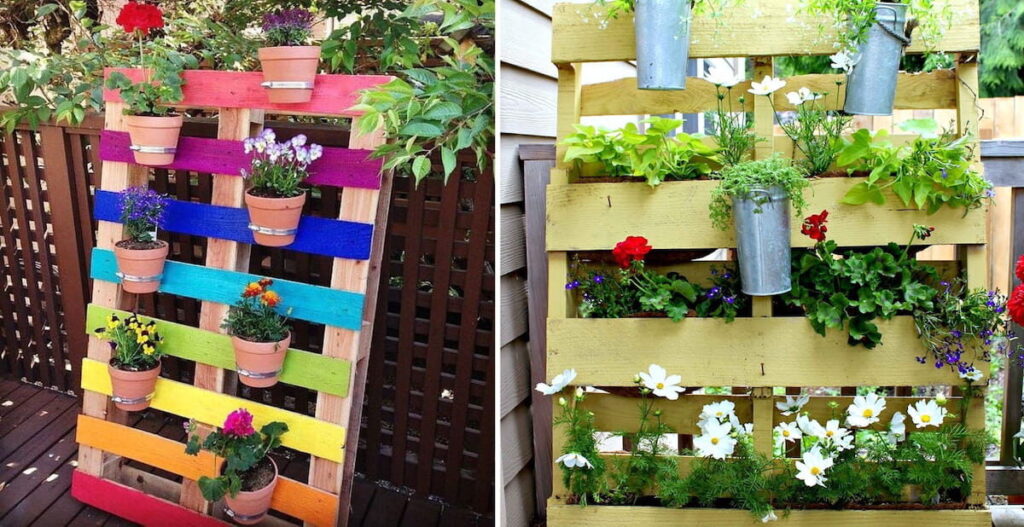
Another simple, yet interesting way to create a vertical flower bed is by using pots of different sizes.
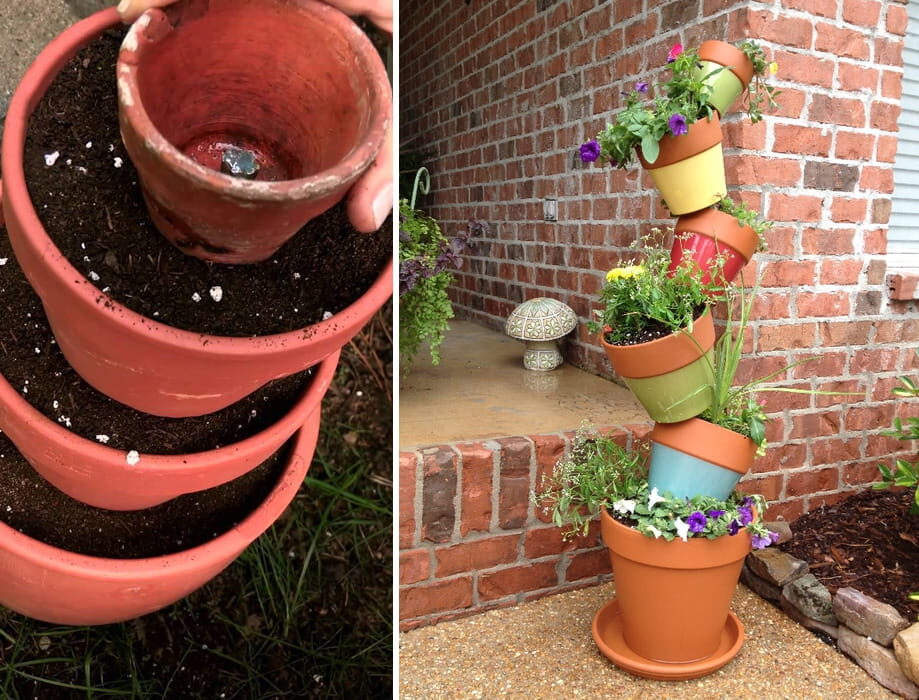
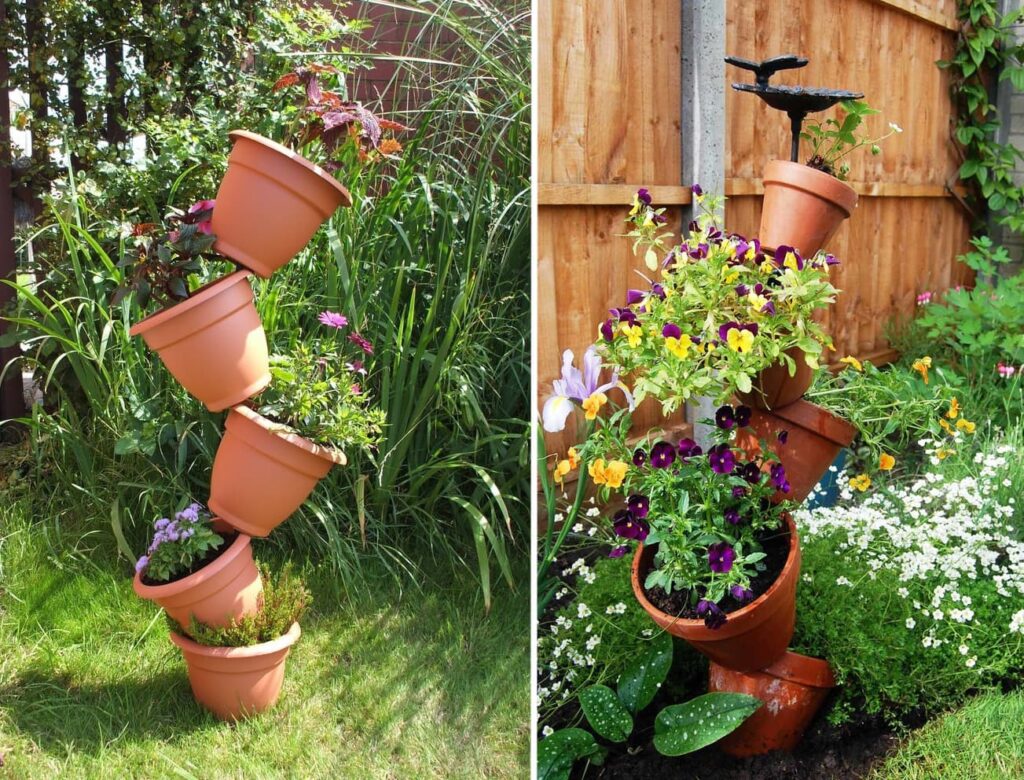
Carpet flower bed
Usually, such flower beds are located against the background of pebbles, lawns, sand areas, but they can be placed in any other place, as long as the carpet flower bed in the garden harmoniously fits into the overall landscape design of the yard.
By drawing inspiration from experienced designers’ ideas, you can create intriguing ornamental patterns that give the illusion of a luxurious carpet spread out in your yard.
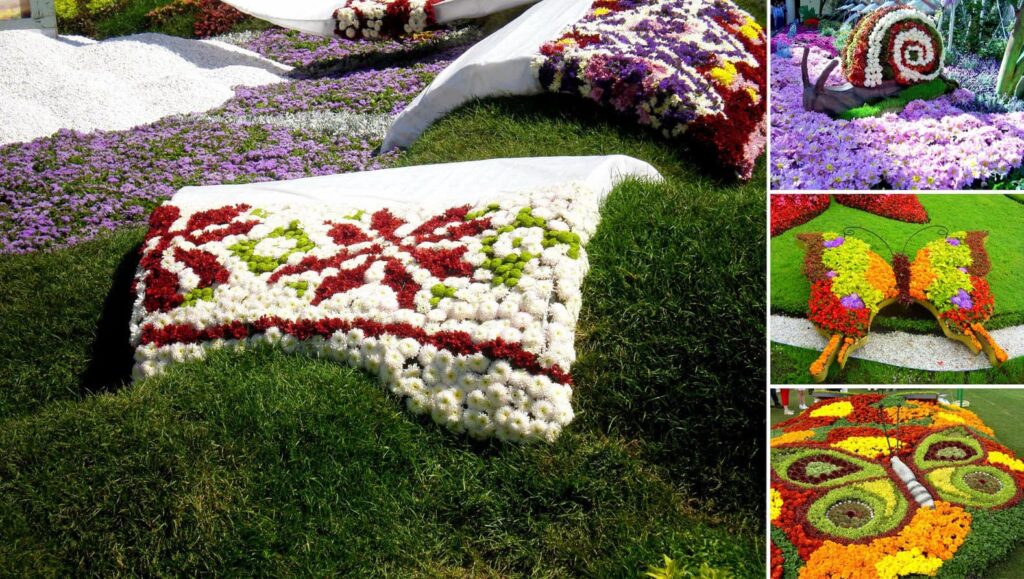
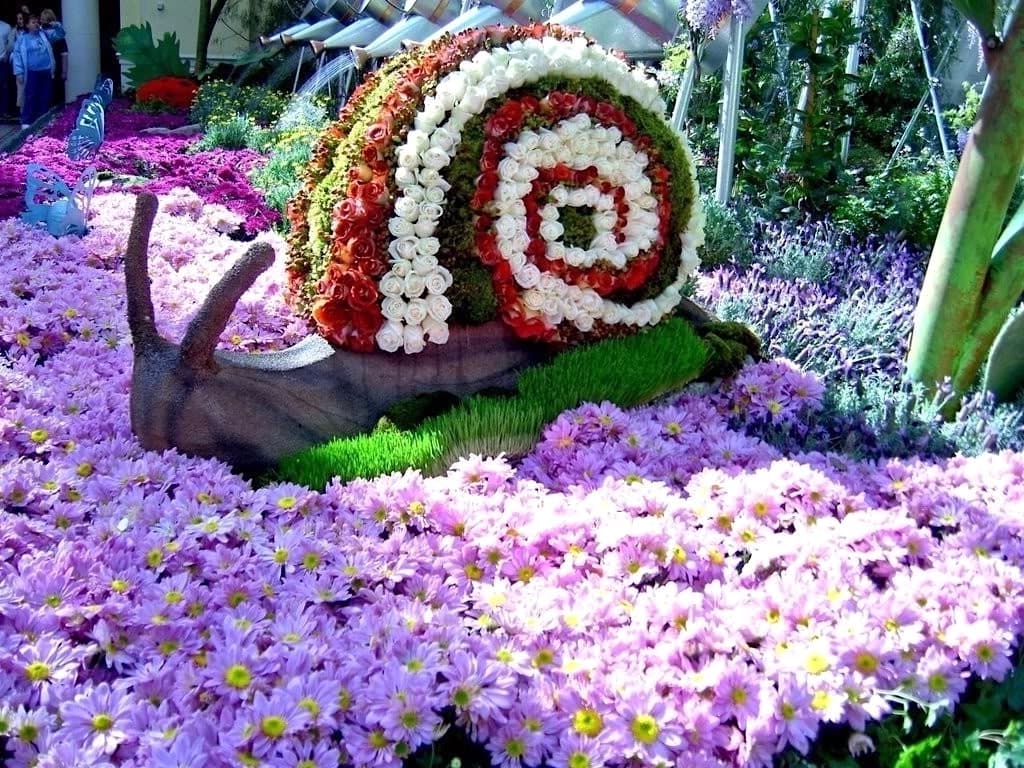
Best options for flower bed borders
An easy way to enhance the decorativeness of flower beds is to install a border around the perimeter, which allows you to emphasize the configuration of the flower bed and prevent soil erosion throughout the growing season.
Stone borders
To obtain an aesthetic border, the easiest option is to lay out fairly large boulders of different shapes in a shallow trench dug around the perimeter of the flower bed. This creates a finished structure for the flower bed, which maintains an aesthetically pleasing and neat appearance for a long time.
Stone walls that elevate flower beds above ground level also look impressive. To create them, place large rocks in a trench and fill the gaps with soil. Then, lay several layers of smaller boulders, fastening them with cement.
Tip!
Stone formations enclosed in a wire mesh construction also look expressive. You can create them at varying heights and arrange them along the flower bed’s edge. Such a composition looks exquisite and serves as an additional decorative element that does not lose its attractiveness even without vegetation.



Wooden borders for a flower bed
Wooden borders are easy to install and give a modern and beautiful look to the flower bed, but they may not be as durable in our climate conditions.
Here are some ideas that may inspire you:
- Create an interesting border by burying planks of different widths around the perimeter of the flower bed. Round logs can also be used for this purpose.
- Half-cut circles made from logs buried to half their diameter also create an interesting effect.
- For a decorative border, often stakes or scrap pieces of wood are used. If desired, these wooden elements can be sanded, coated with varnish, or painted.
- Long boards can also be used as borders. They can be attached to the sides of flower beds with rectangular, triangular, trapezoidal, or square shapes.
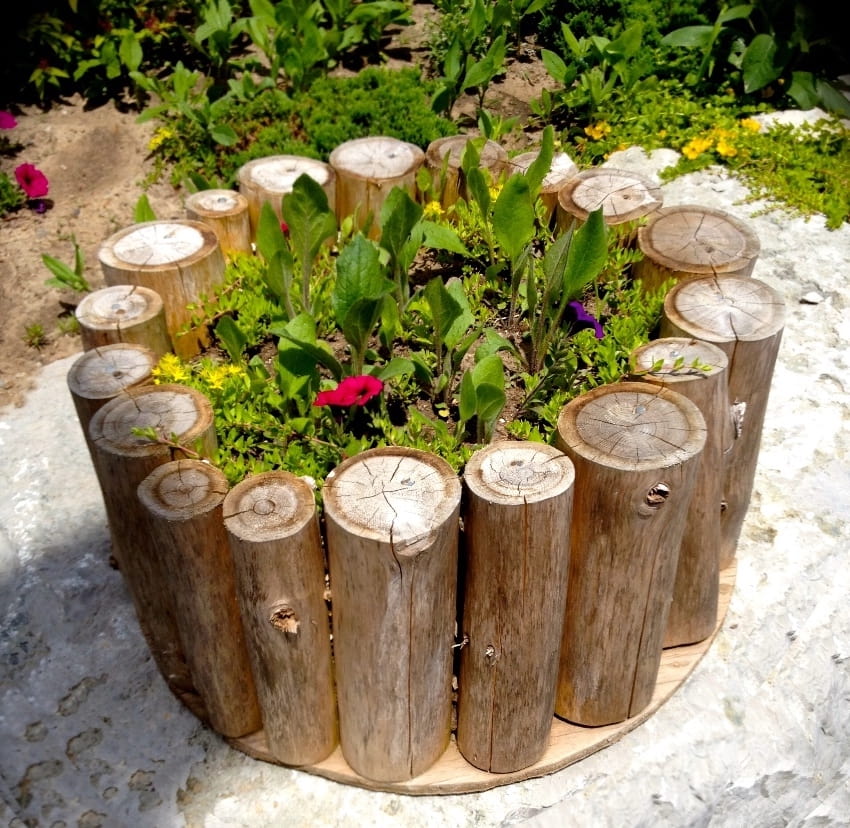
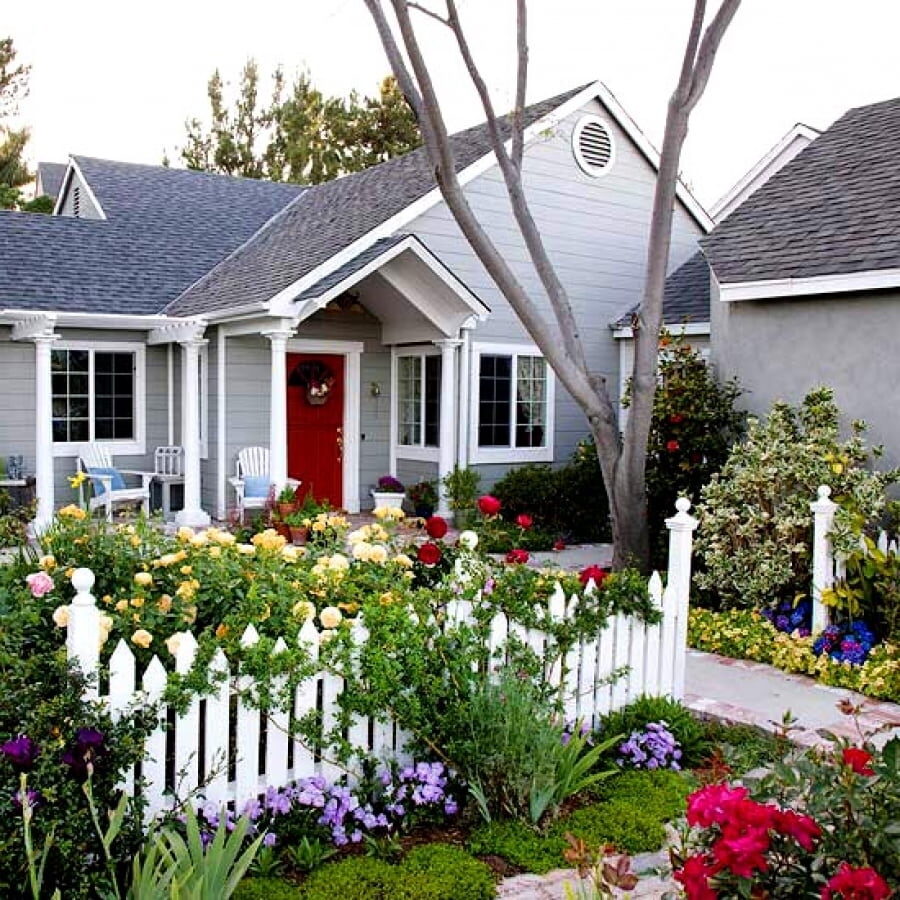
From leftover pickets, it is easy to assemble a fence, creating various smooth or pointed lines along the top edge. Fences woven from willow twigs give a retro sound.
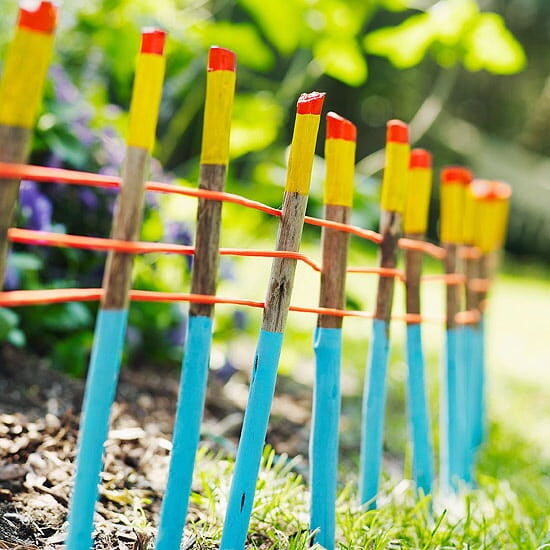
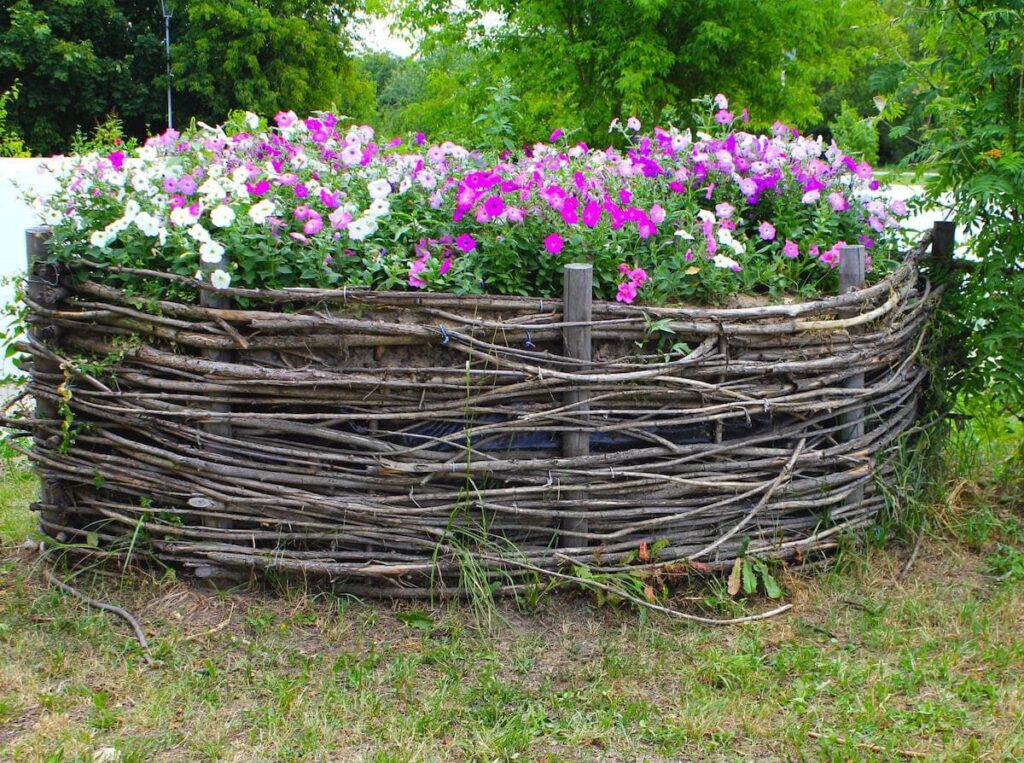
Plastic fences
Durable plastic has gained popularity for use in constructing fences around flowerbeds. They are easy to install, and the variety of colors allows you to choose the right shade.
Indeed, striped options are popular choices due to their flexibility, which allows them to easily adapt to the curves and contours of a flower garden.You secure these borders in shallow trenches. You can also choose from interesting textures that imitate brick, stone, and wood.
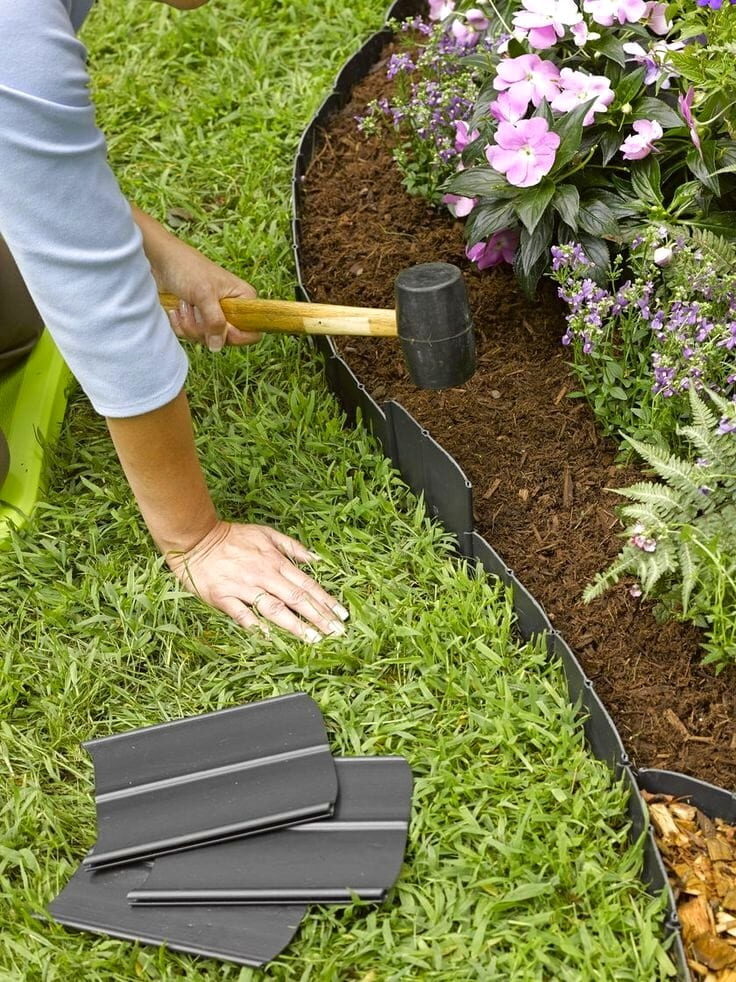
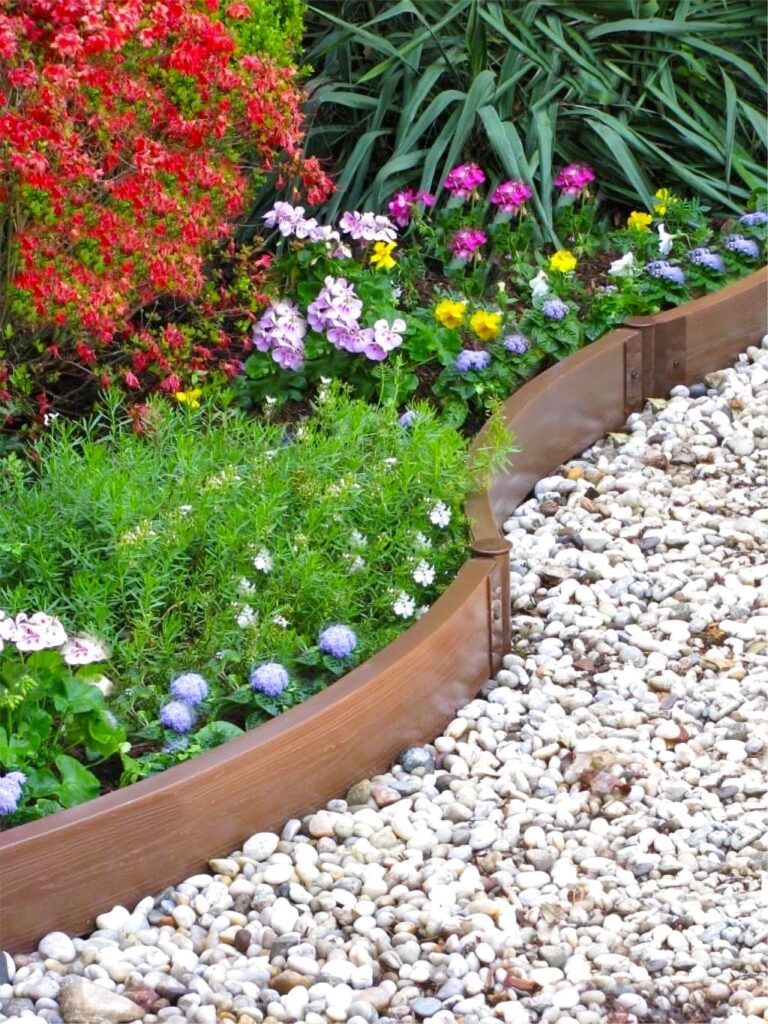
Metal fences for flowerbeds
Ornate wrought iron structures create a special charm. Such fences beautifully complement the greenery of the plants, enhancing the decorative appeal of the flowerbeds.
It is important to carefully consider the overall composition, taking into account appropriate stylistic elements such as lanterns, bench legs, or porch railings.
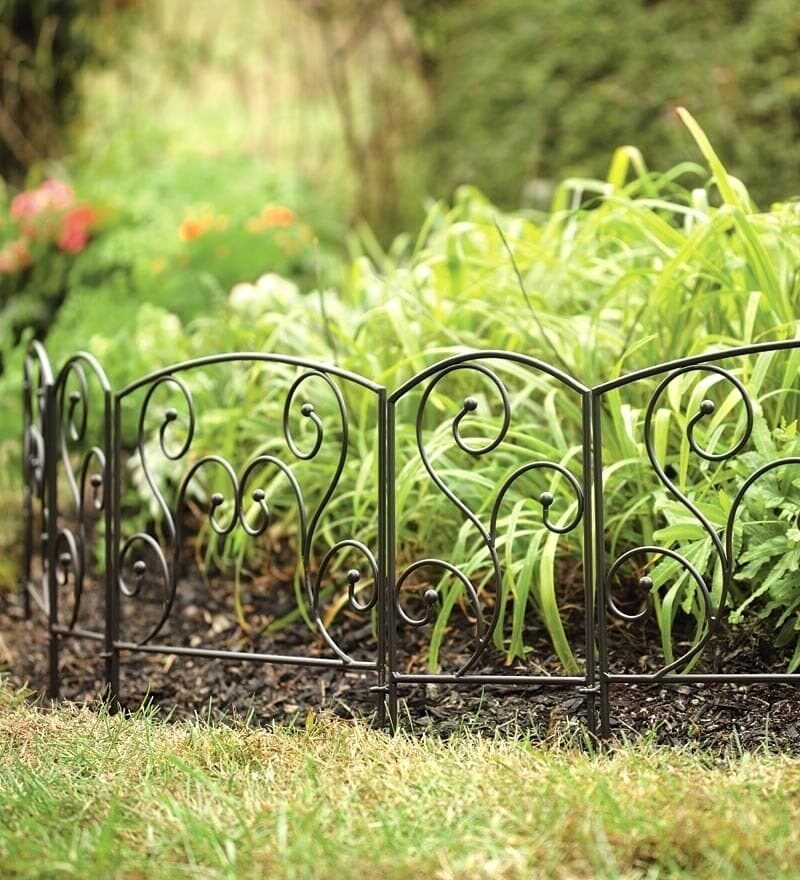
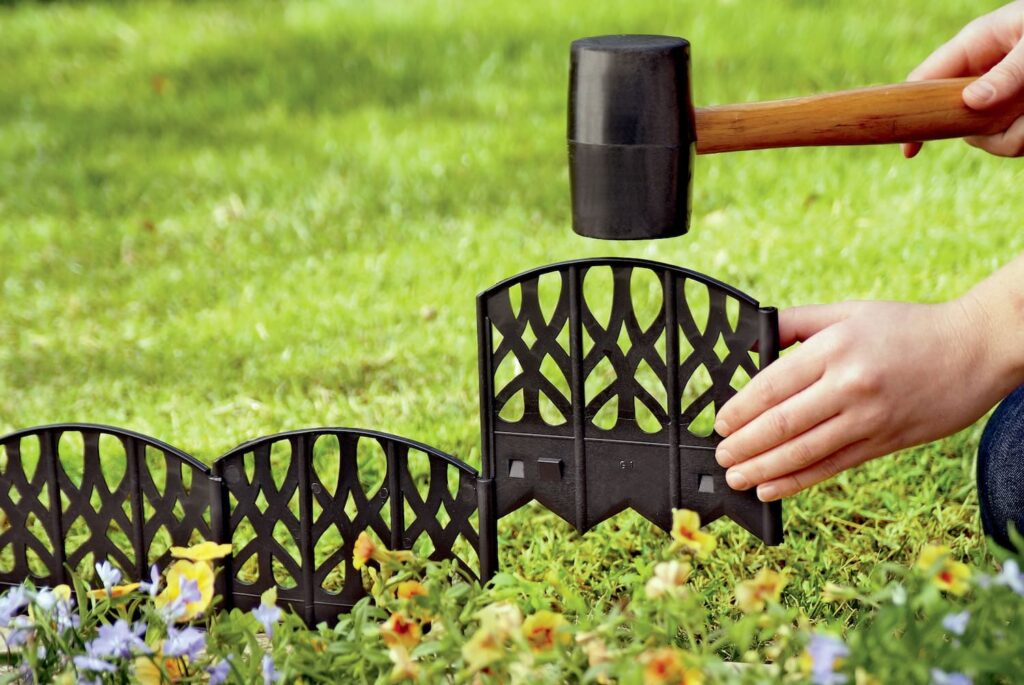
DIY Concrete Fences
When creating a long-lasting flowerbed for your garden, you can make a concrete fence with your own hands.
To achieve this, you install flexible cardboard of the necessary height on both sides of a shallow trench dug around the perimeter. You maintain the width using struts. Then, all you have to do is pour in the concrete and wait for it to harden.
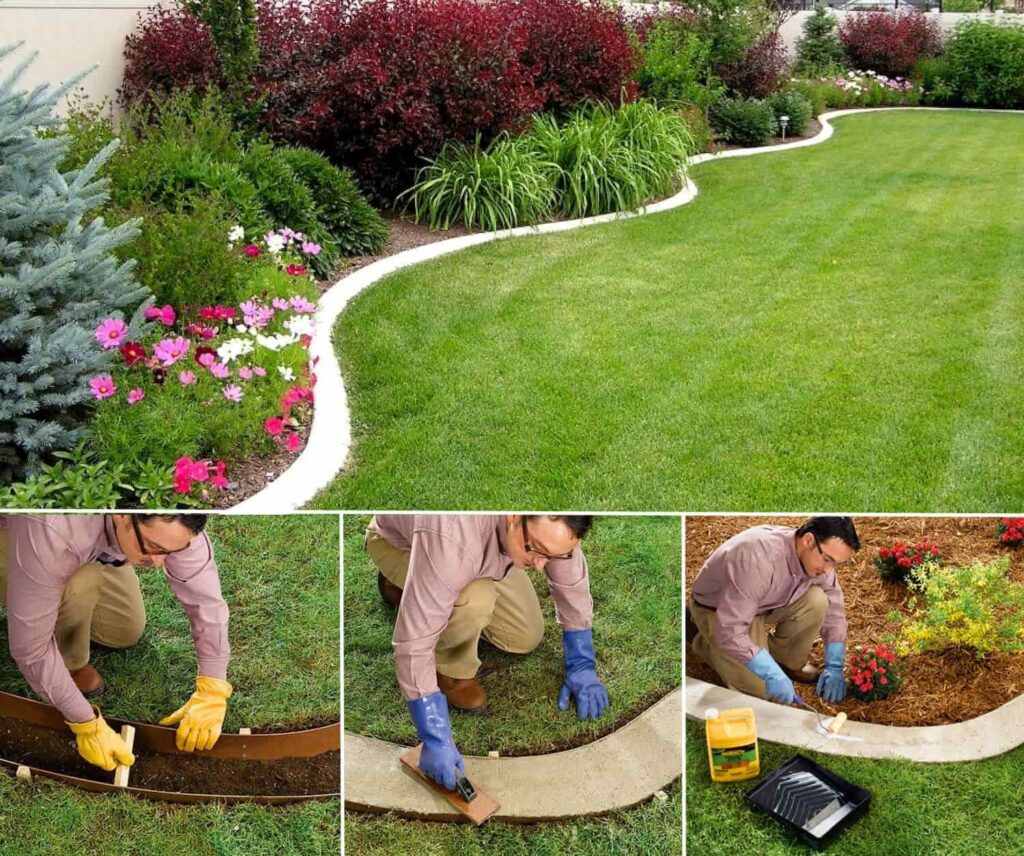
Flowerbeds without Fences
The easiest option involves creating a flowerbed without additional fencing around the perimeter. You dig up and arrange the soil in the desired shape, making sure it rises above the surface. You can elevate the center or background for added depth.
Creating even lines with such constructions can be challenging because the soil tends to crumble and settle after watering. You can address this issue by using a flexible border tape. You lay this tape in a groove that you’ve dug around the flowerbed’s perimeter and then cover it with soil. This creates a clear and stable line.
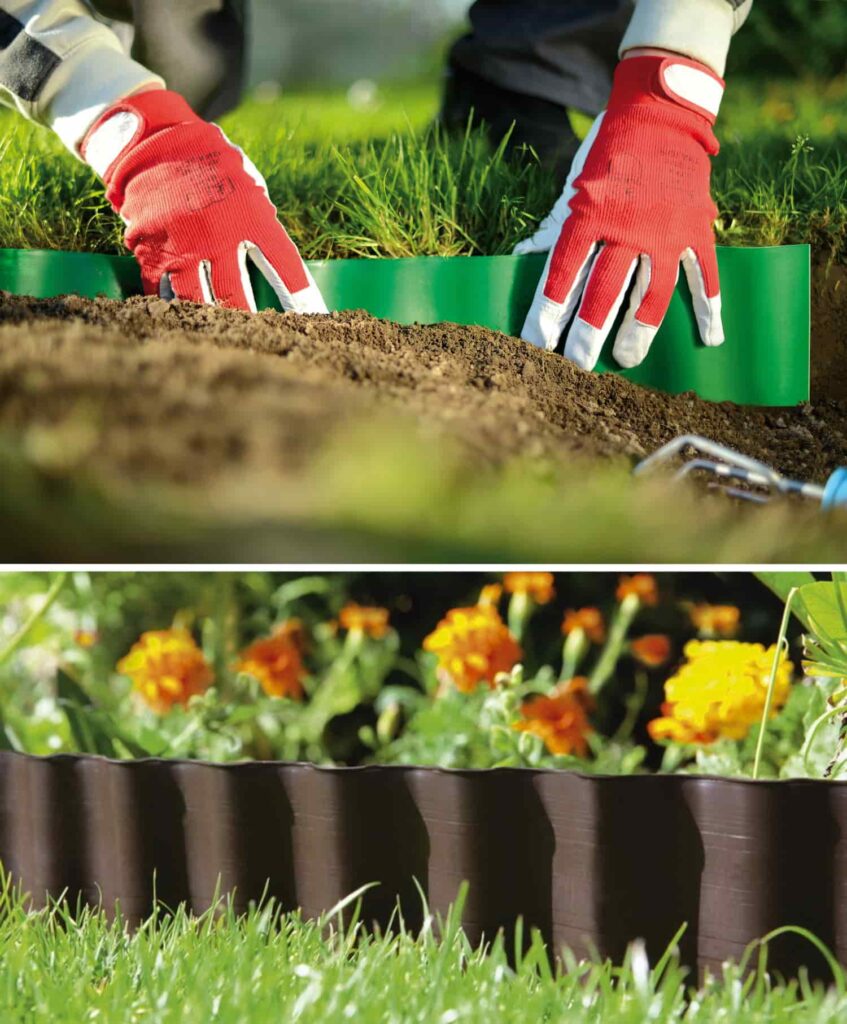
Beautiful DIY Flowerbeds + Photos
Modern designs of flowerbeds with unusual shapes give the landscape individuality, enliven it, and fill it with a sense of comfort and celebration. Let’s explore the types of flowerbeds you can create at home using readily available materials.
Floating Flowerbeds
Among the latest hits in landscape design are floating flowerbeds. Their arrangement requires a water feature. If needed, a water-filled tub or a children’s pool can serve this purpose.
- For a floating flowerbed, lightweight material such as foam is required, capable of not sinking with pots of flowers attached to its surface.
- Depressions can be made on the floating island, filled with soil, and planted with low compact plants.
- The banks of the water feature are covered with pebbles. This material looks especially effective after coloring.
- The overall picture can be complemented with groups of plants, a convenient bench, and an elegant table.
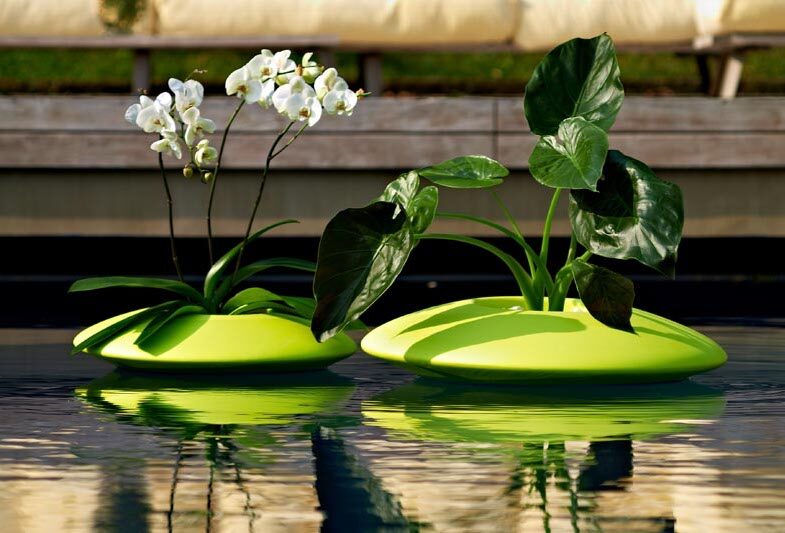


Tip!
You can decorate a bathtub or any other water container with aquatic plants grown in pots. They can be placed directly in the water, creating interesting compositions.
Butterfly Garden Design
- With a little effort, you can create a magnificent, multicolored butterfly on your lawn.
- First, develop a scheme that allows you to maintain clear lines and symmetry of the design.
- Then, use wire to outline the butterfly’s configuration on the surface, and then fill in the area with soil and plant flowers.
- A flower bed that imitates a rising butterfly looks unusual. You will need a special structure that lifts it up on a support from the front. Typically, pots with blooming plants are placed inside.
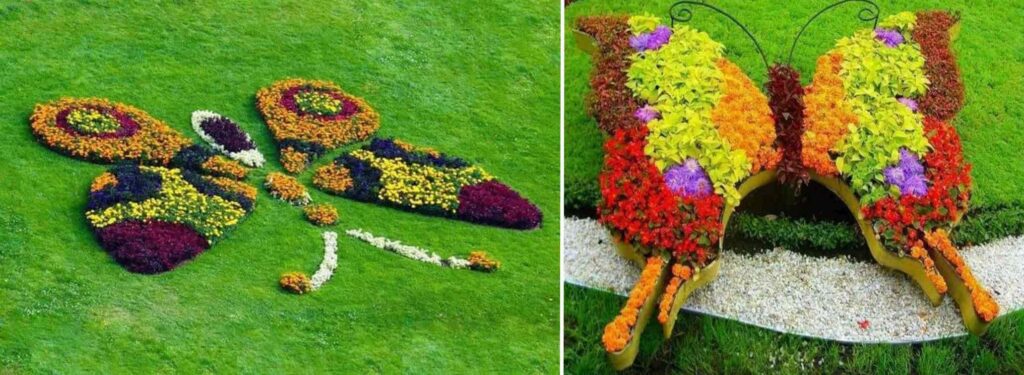
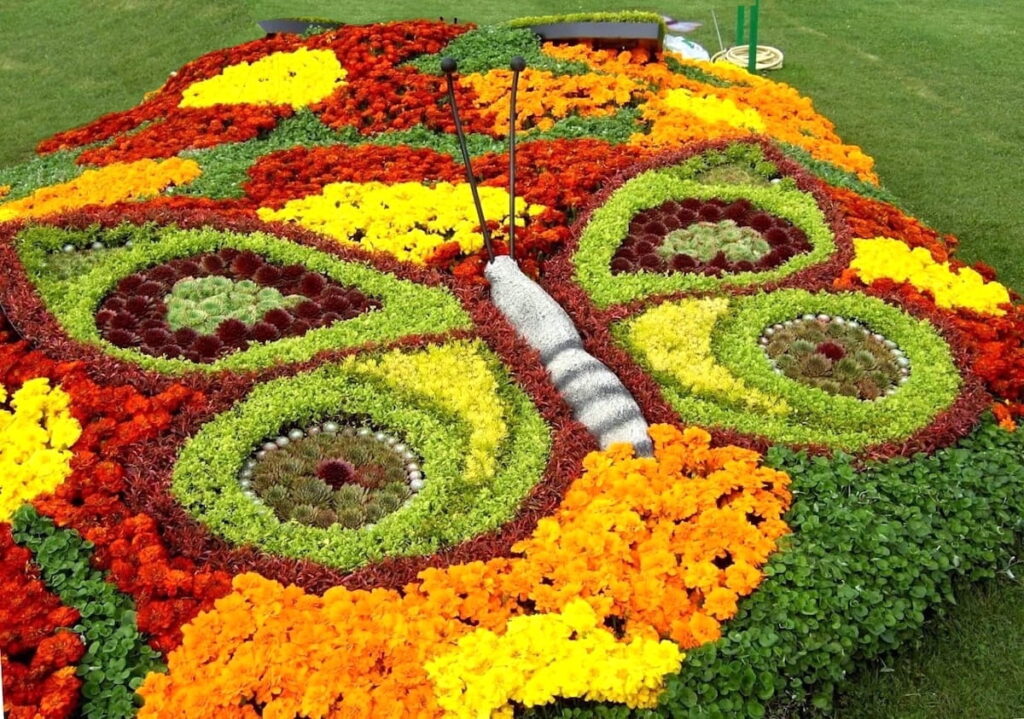
Flower Streams
Beautiful flower streams enchant with their elegant interweaving and curves, captivating with a rich palette of shades.
- To create a plant stream, any containers of elongated shape can be used – pots, tubs, small barrels. They are laid on their sides, buried if necessary, so that the neck touches the ground surface.
- A soil mixture is added inside, and the twists of the future stream are marked from the neck. The stream is dug up, adding soil if necessary.
- Plants of the same color are selected or a riot of different shades is created. They are planted directly into the container and fill the channel.
During the flowering stage, an incredibly wonderful decorative element is created, attracting attention and decorating the surrounding landscape.
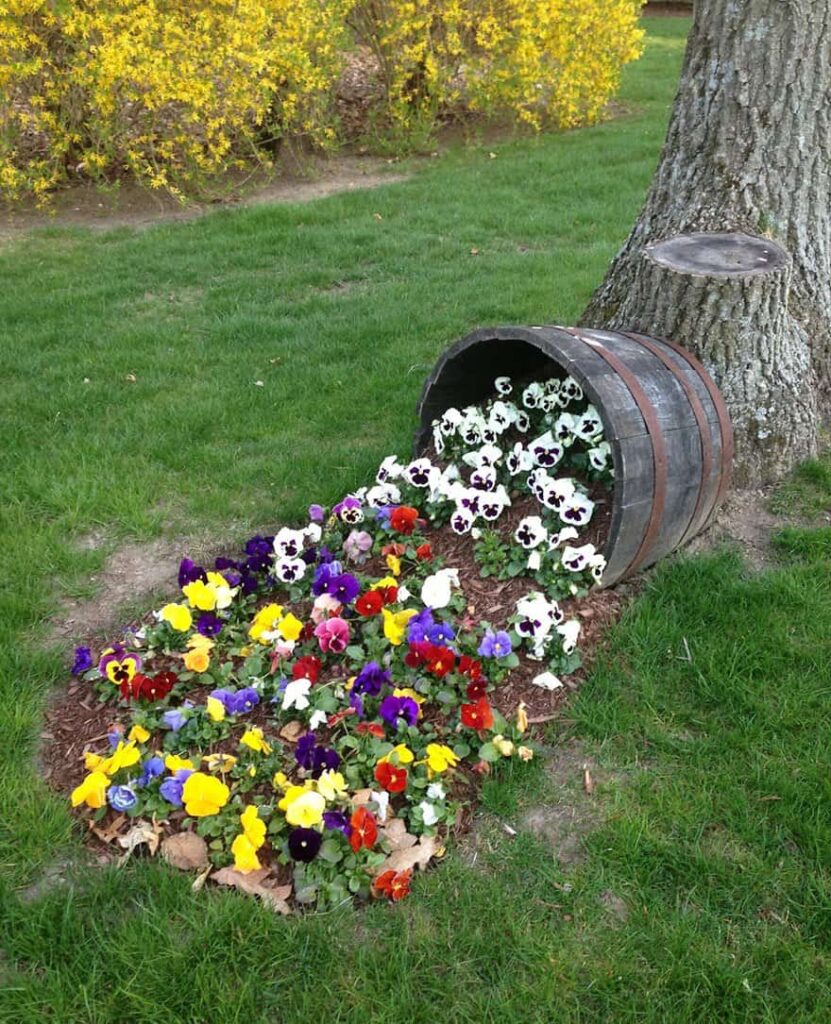
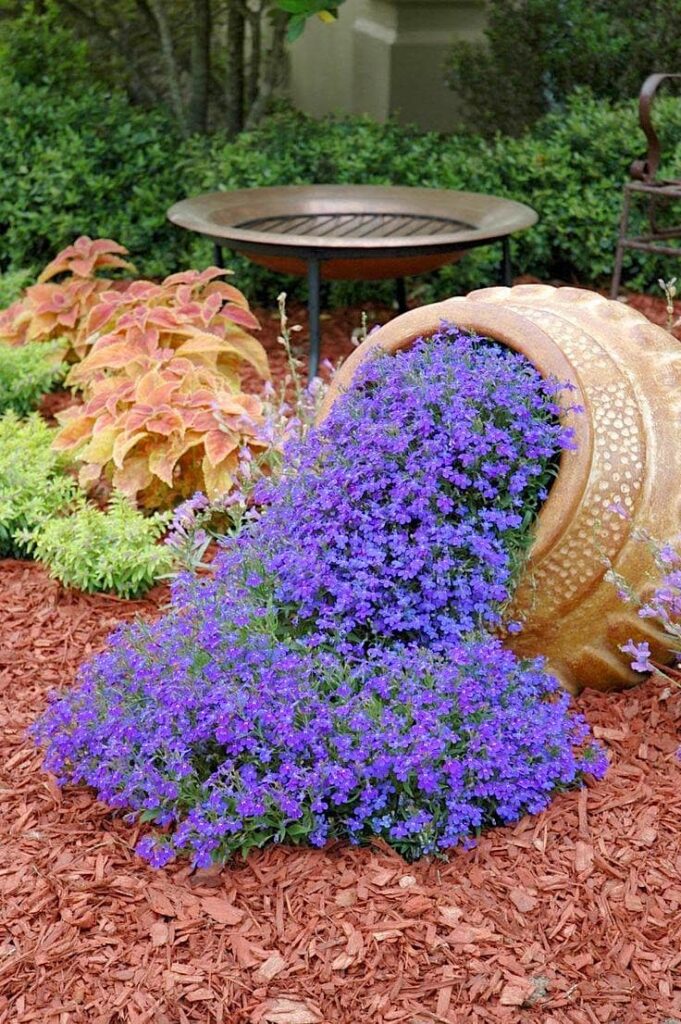

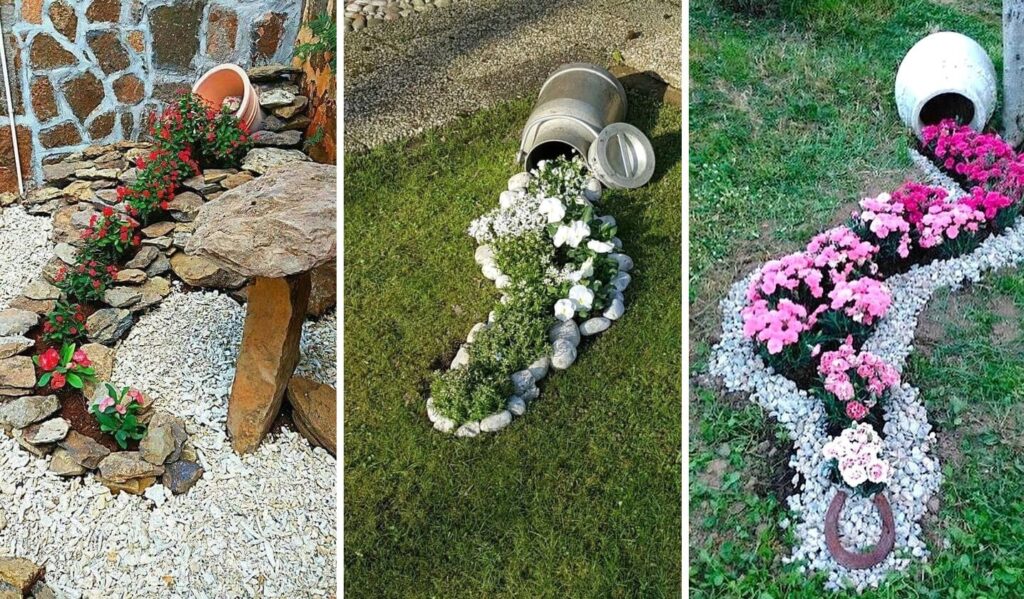
Aesthetic of Wood
- Original compositions can be created by placing a thick log on its side and carving out a portion of the wood deep enough to plant flowers.
- The bottom of the log is lined with plastic sheeting, and soil is added on top.
- All that remains is to plant flowers in the soil and water them generously. A flower bed made from a log is ready and waiting for you to enjoy.
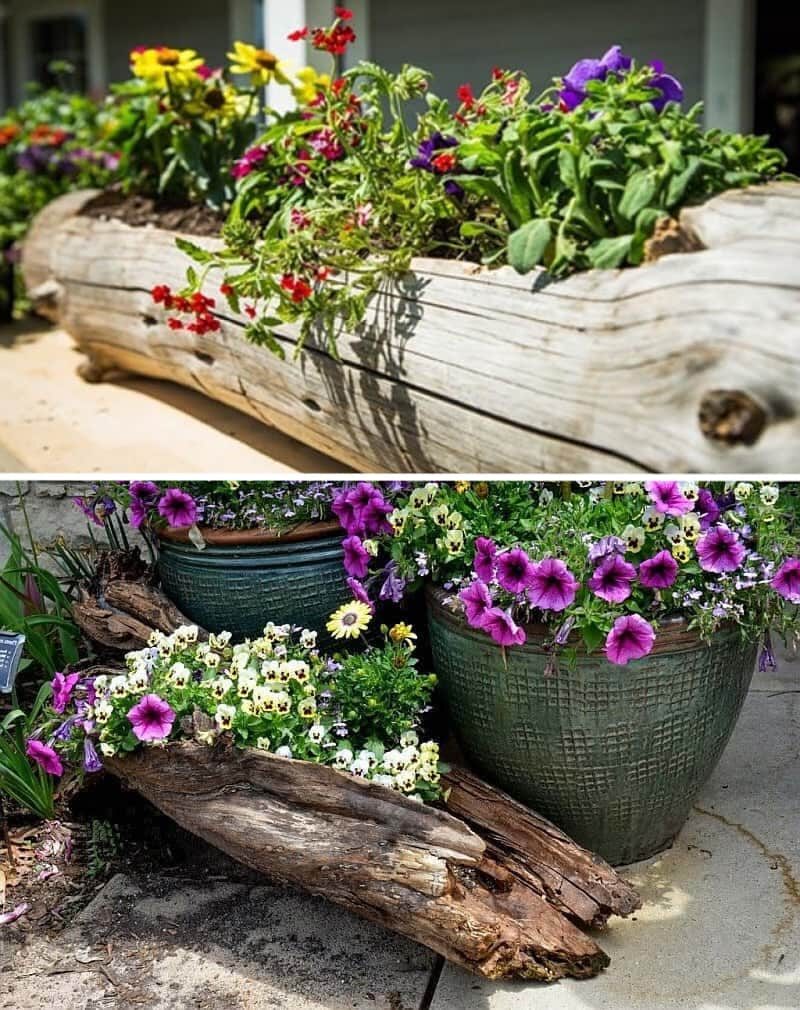

Flower Beds Made from Old Items
You can give a site an unexpected and fresh look using old items that are no longer in use. First, inspect these items and, if necessary, polish, lacquer, or paint them for a renewed appearance. Interesting patterns, intricate inscriptions, and images of animals, butterflies, and insects can be drawn on them.
What can be used to make a flower bed at a summer house?
- Old suitcases, dressers, and wheelbarrows can be used. The bottom is covered with plastic sheeting and filled with soil.
- It’s even easier to use pots with blooming plants that can be changed regularly, constantly creating new color combinations.
- Chairs, opened umbrellas, pots, buckets, watering cans, and shoes can be used for exclusive flower beds.
- After minor restoration, beds, bicycles, baskets, bathtubs, barrels, and tubs can also be used.
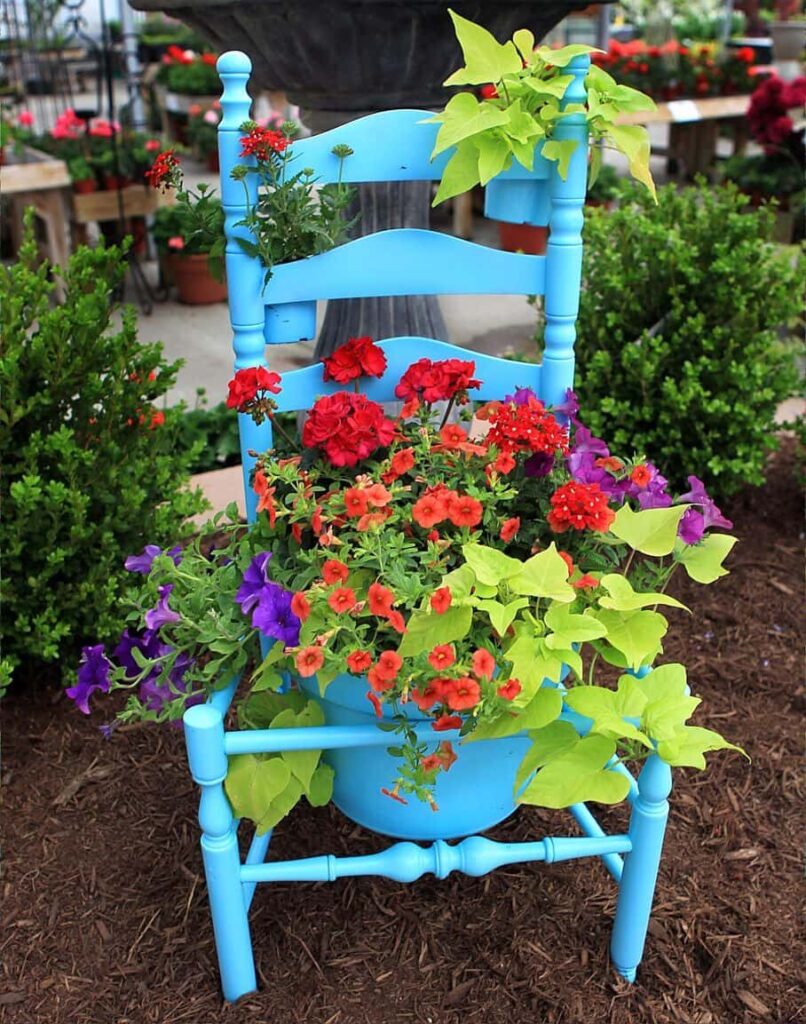
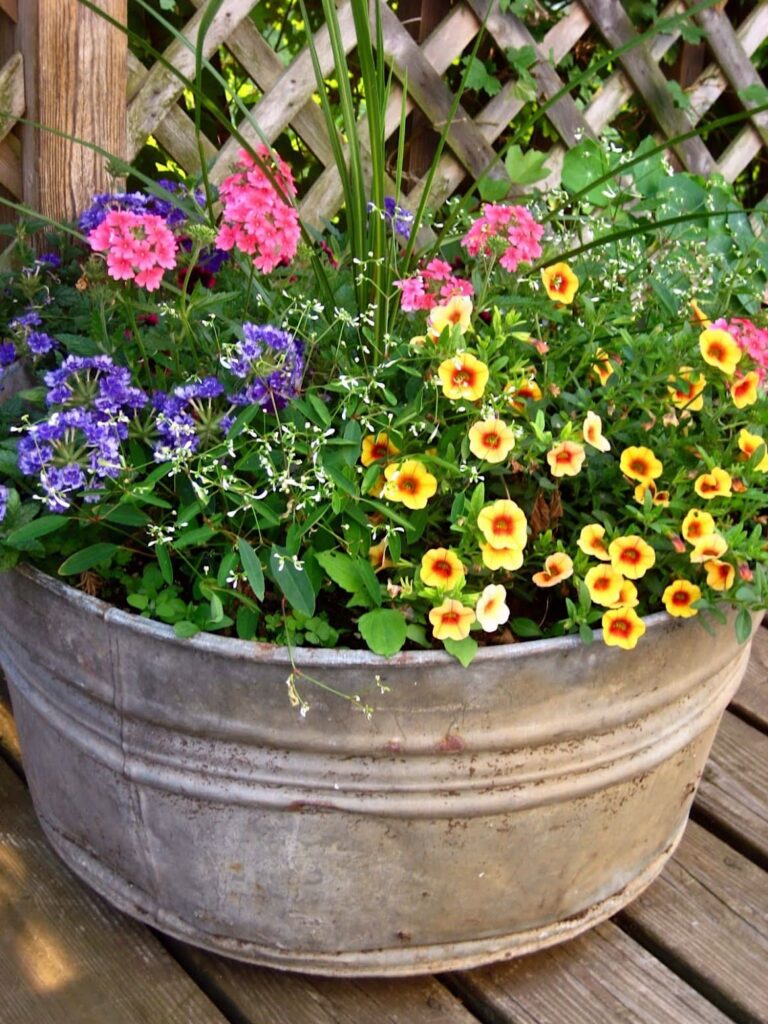
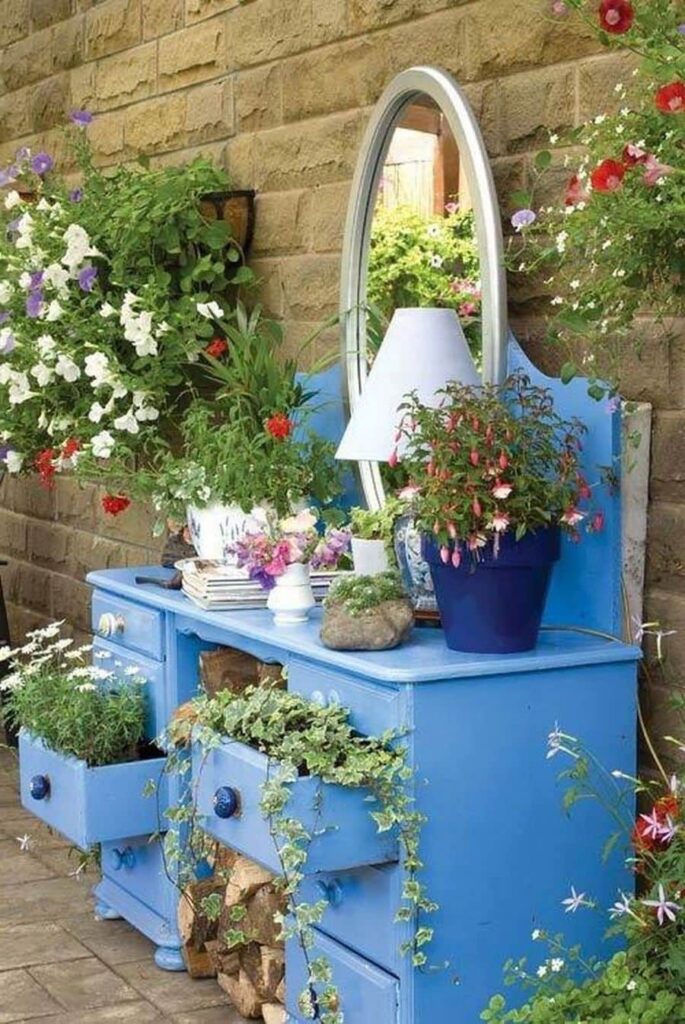

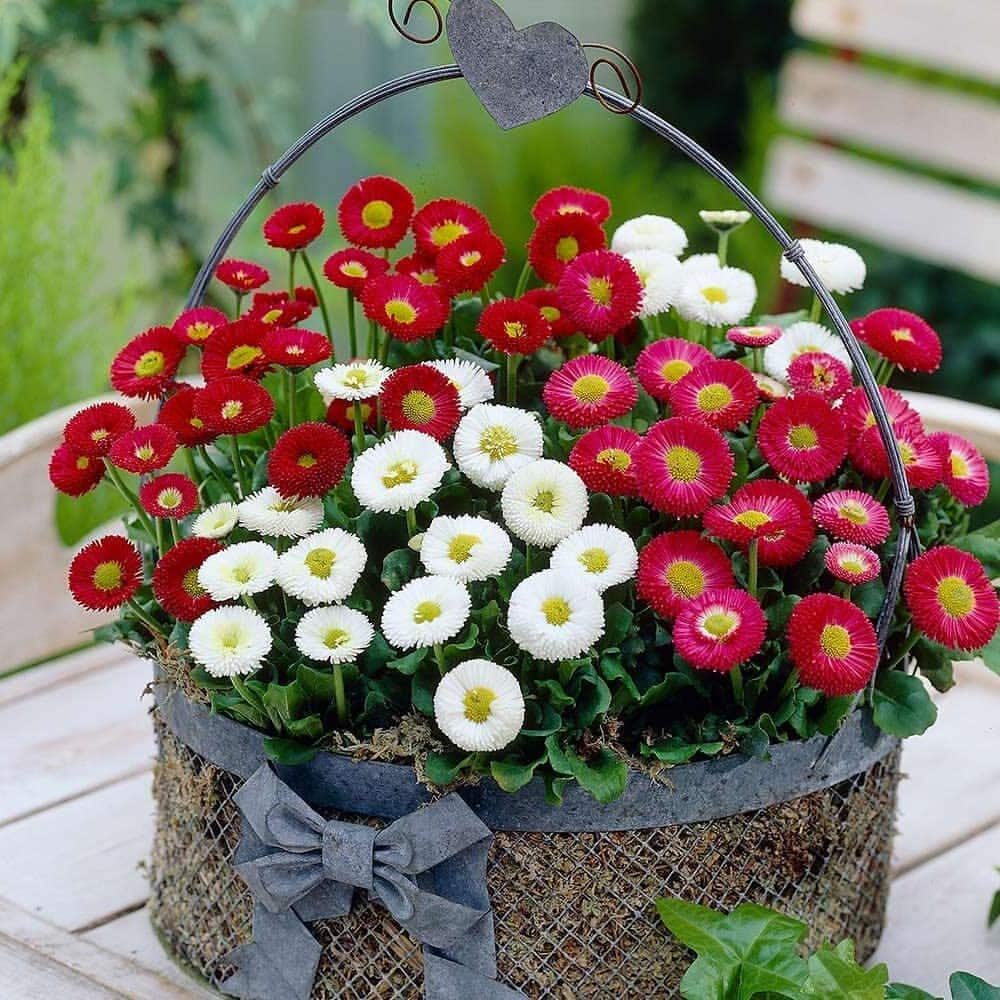
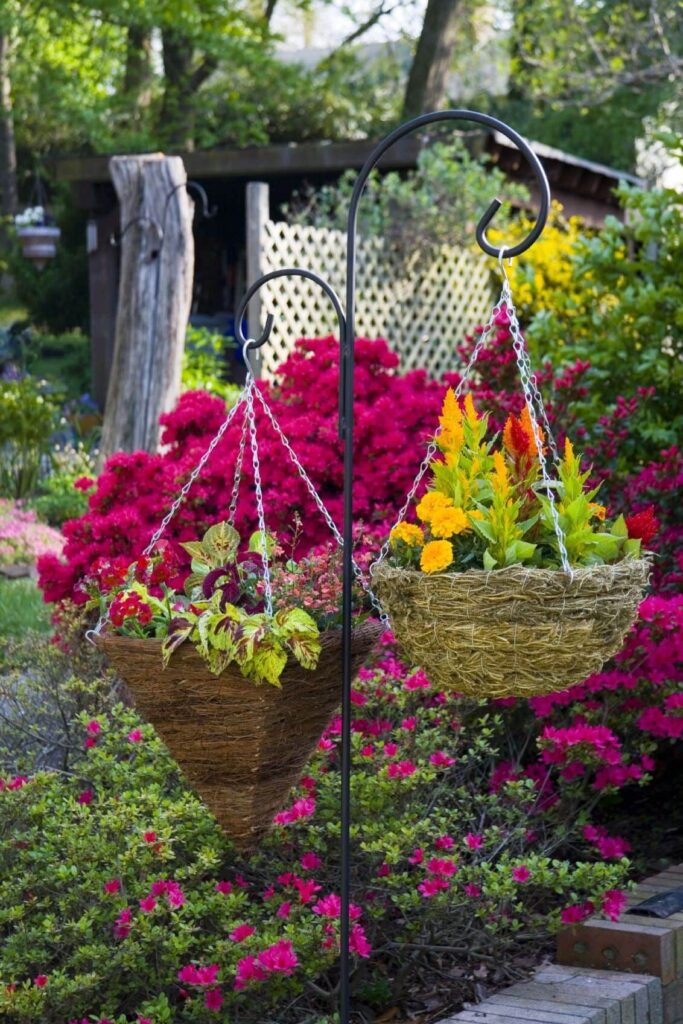
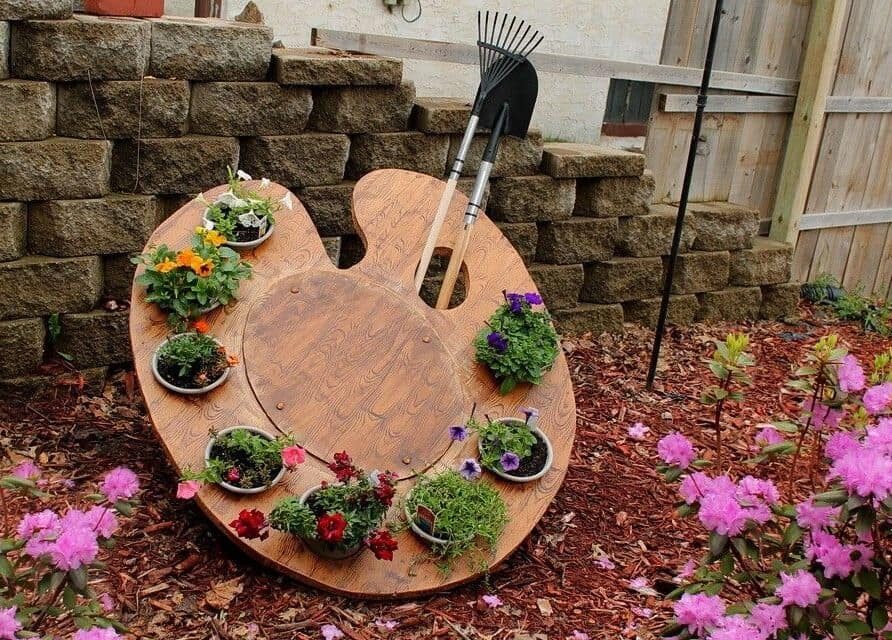
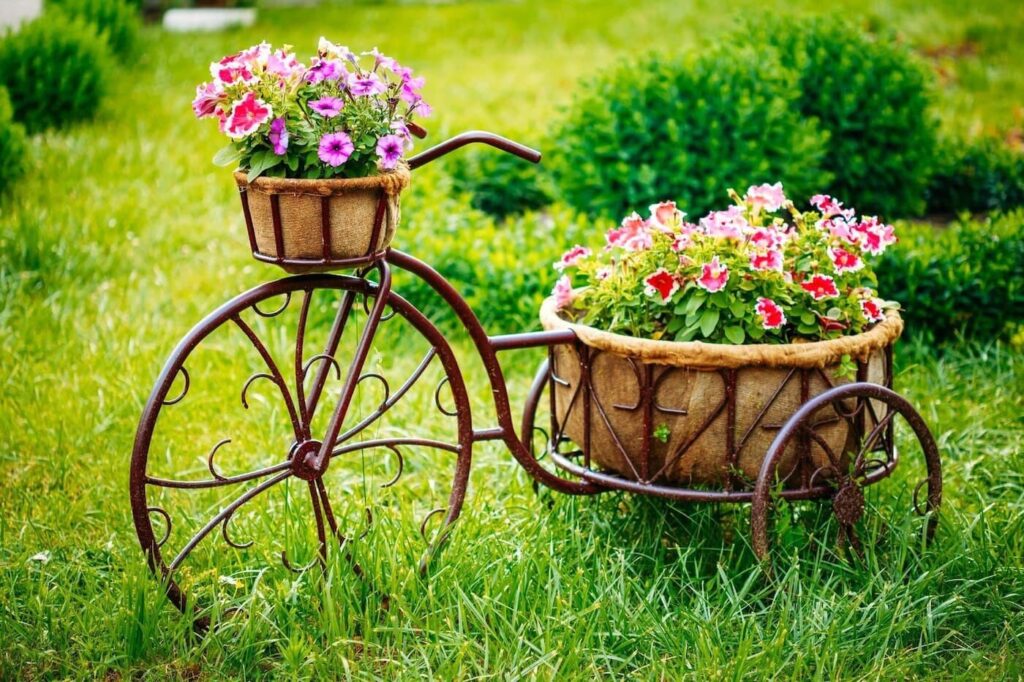
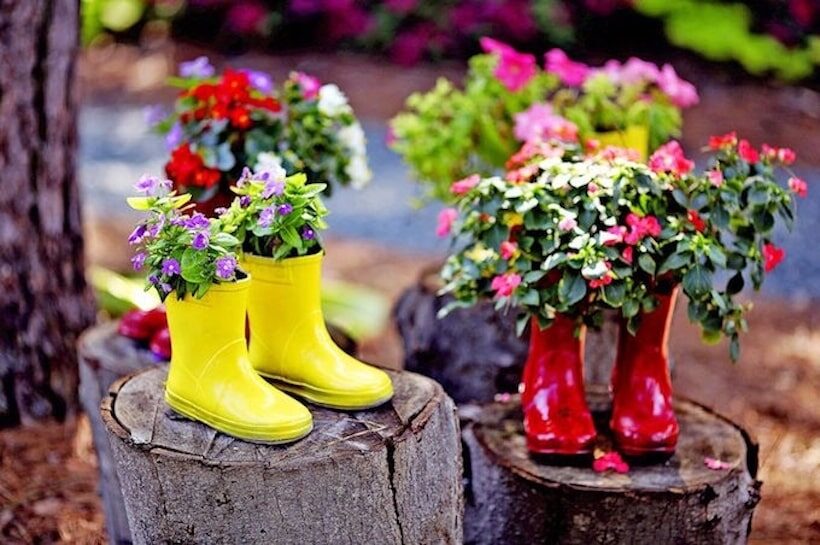
Designing a future flower bed that will decorate your summer cottage allows you to bring your own creative ideas to life. The result is the creation of an unusual flower bed design that transforms even the most modest landscape.
We hope that our ideas, tips, and real photos of flower beds have been helpful to you. And remember, if you want your garden to be beautiful, it’s important to invest not only your energy but also your soul into its design.


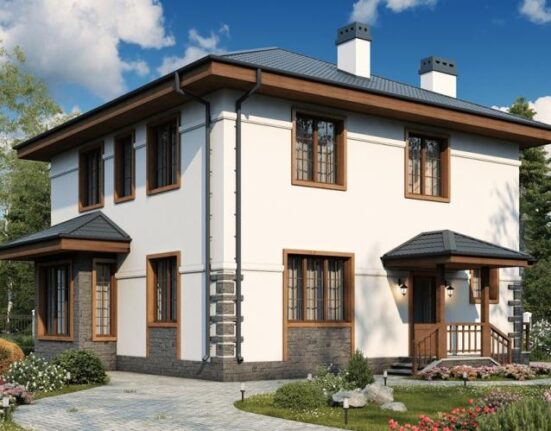

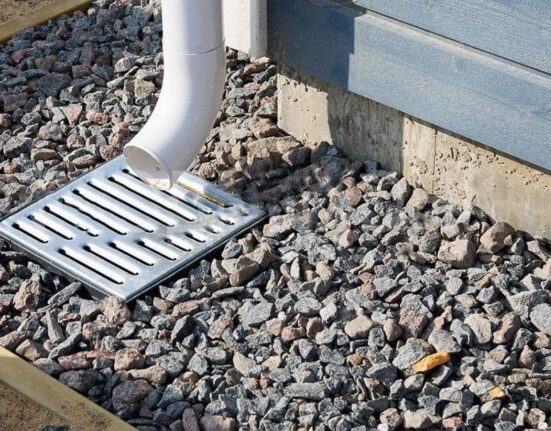
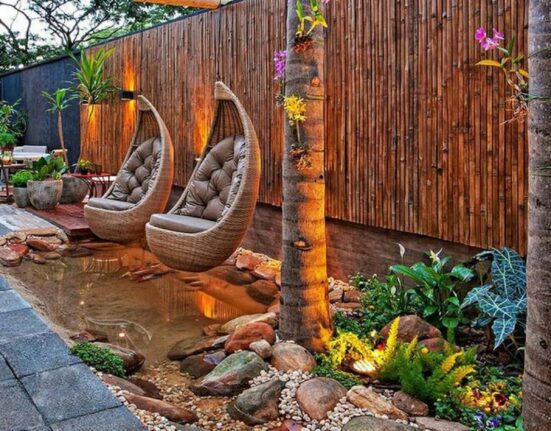
Leave feedback about this